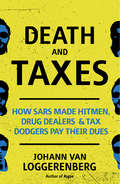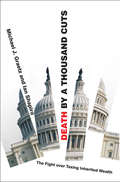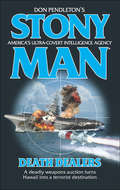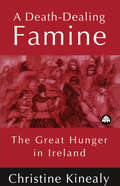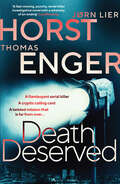- Table View
- List View
The Death and Rebirth of American Radicalism
by Stanley AronowitzThe Death and Rebirth of American Radicalism differentiates the "Social Justice Left" from "Cultural Radicalism" and the various social movements for individual freedom. In The Death and Rebirth of American Radicalism, Stanley Aronowitz asks the question, "Is there anything left of the Left?" With the rise of Newt Gingrich and his "Contract With America," how is it that conservativism staged such a remarkable recovery after being discounted in the turbulent 1960s? Aronowitz addresses these and other burning issues of contemporary politics.
The Death and Rebirth of American Radicalism
by Stanley AronowitzThe Death and Rebirth of American Radicalism differentiates the "Social Justice Left" from "Cultural Radicalism" and the various social movements for individual freedom. In The Death and Rebirth of American Radicalism, Stanley Aronowitz asks the question, "Is there anything left of the Left?" With the rise of Newt Gingrich and his "Contract With America," how is it that conservativism staged such a remarkable recovery after being discounted in the turbulent 1960s? Aronowitz addresses these and other burning issues of contemporary politics.
Death and Religion in a Changing World
by Kathleen Garces-FoleyThis comprehensive study of the intersection of death and religion offers a unique look at how religious people approach death in the twenty-first century. Previous scholarship has largely focused on traditional beliefs and paid little attention to how religious traditions evolve in relation to their changing social context. Employing a sociological approach, "Death and Religion in a Changing World" describes how people from a wide variety of faiths draw on and adapt traditional beliefs and practices as they deal with death in modern societies. The book includes coverage of newly emerging social and religious phenomena that are only just beginning to be analyzed by religion scholars, such as public shrines, the role of the media, spiritual bereavement groups, and the use of the Internet in death practices.
Death and Religion in a Changing World
by Kathleen Garces-FoleyThis comprehensive study of the intersection of death and religion offers a unique look at how religious people approach death in the twenty-first century. Previous scholarship has largely focused on traditional beliefs and paid little attention to how religious traditions evolve in relation to their changing social context. Employing a sociological approach, "Death and Religion in a Changing World" describes how people from a wide variety of faiths draw on and adapt traditional beliefs and practices as they deal with death in modern societies. The book includes coverage of newly emerging social and religious phenomena that are only just beginning to be analyzed by religion scholars, such as public shrines, the role of the media, spiritual bereavement groups, and the use of the Internet in death practices.
Death and security: Memory and mortality at the bombsite (PDF) (New Approaches to Conflict Analysis)
by Charlotte Heath-KellyA comparative study of memorialisation and reconstruction in post-terrorist bomb sites, which argues that security practices are fundamentally connected to death anxiety.
Death and security: Memory and mortality at the bombsite (New Approaches to Conflict Analysis)
by Charlotte Heath-KellyA comparative study of memorialisation and reconstruction in post-terrorist bomb sites, which argues that security practices are fundamentally connected to death anxiety.
Death and Social Policy in Challenging Times
by Liam Foster Kate WoodthorpeThe study of death has the capacity to bring together a range of policy areas. Yet death is often overlooked within policy debates in the UK and beyond, and within gerontology. Bringing together a range of scholars engaged in policy associated with death, this collection provides a holistic account of how death factors in social policy. Within this, issues covered include inheritance, palliative care, euthanasia, funeral costs, bereavement support, marginalised deaths and disposal practices. At the heart of the book, the volume recognises that the issues identified are likely to intensify and expand over the next twenty years, as death rates continue to rise.
Death and Taxes: How SARS made hitmen, drug dealers and tax dodgers pay their dues
by Johann van LoggerenbergNothing in life is certain, except death and taxes – or so the expression goes. And over the past two decades South African criminals and tax dodgers have come to realise this truth the hard way.Tax sleuth Johann van Loggerenberg was at the centre of many of SARS’ high-profile cases during his time there. As far as SARS is concerned all forms of income are subjected to tax, even if by ill-gotten means. Whether you are a drug dealer from Durban, one of the hitmen who shot Brett Kebble or soccer boss Irvin Khoza, you have to pay your dues!Van Loggerenberg relates the riveting inside stories of the investigations into businessmen like Dave King, Billy Rautenbach, Barry Tannenbaum and his ponzi scheme, and others. Over the years he got to know all the scams and dirty tricks in the book and he explains these in plain language.In these investigations the tax authority worked closely with the police, the NPA and the Directorate of Special Operations. However, after a few years SARS became the victim of its own success. In telling the stories of how tax evaders were caught, Van Loggerenberg also shows how the power struggle between different state departments and the phenomenon of state capture in recent years started crippling SARS.
Death as a Way of Life: Dispatches from Jerusalem
by David GrossmanIn autumn 1993 the Oslo Agreements were signed by Yitzhak Rabin and Yasser Arafat, marking the beginning of promise for a constructive peace between the Israelis and the Palestinians. The ten years that followed were charted first by hope and optimism only to deteriorate into revenge and violence. Throughout this decade David Grossman has published articles in the American and European press, written in a personal voice - father, husband, peace activist, novelist - as he witnesses devastating events, he cries out with a prophetic wisdom, imploring both sides to return to sanity, to negotiations. The publication of this collection of articles will mark ten years to the dream of Oslo.
Death by a Thousand Cuts: The Fight over Taxing Inherited Wealth
by Michael J. Graetz Ian ShapiroThis fast-paced book by Yale professors Michael Graetz and Ian Shapiro unravels the following mystery: How is it that the estate tax, which has been on the books continuously since 1916 and is paid by only the wealthiest two percent of Americans, was repealed in 2001 with broad bipartisan support? The mystery is all the more striking because the repeal was not done in the dead of night, like a congressional pay raise. It came at the end of a multiyear populist campaign launched by a few individuals, and was heralded by its supporters as a signal achievement for Americans who are committed to the work ethic and the American Dream. Graetz and Shapiro conducted wide-ranging interviews with the relevant players: members of congress, senators, staffers from the key committees and the Bush White House, civil servants, think tank and interest group representatives, and many others. The result is a unique portrait of American politics as viewed through the lens of the death tax repeal saga. Graetz and Shapiro brilliantly illuminate the repeal campaign's many fascinating and unexpected turns--particularly the odd end result whereby the repeal is slated to self-destruct a decade after its passage. They show that the stakes in this fight are exceedingly high; the very survival of the long standing American consensus on progressive taxation is being threatened. Graetz and Shapiro's rich narrative reads more like a political drama than a conventional work of scholarship. Yet every page is suffused by their intimate knowledge of the history of the tax code, the transformation of American conservatism over the past three decades, and the wider political implications of battles over tax policy.
Death by a Thousand Cuts: The Fight over Taxing Inherited Wealth (PDF)
by Michael J. Graetz Ian ShapiroThis fast-paced book by Yale professors Michael Graetz and Ian Shapiro unravels the following mystery: How is it that the estate tax, which has been on the books continuously since 1916 and is paid by only the wealthiest two percent of Americans, was repealed in 2001 with broad bipartisan support? The mystery is all the more striking because the repeal was not done in the dead of night, like a congressional pay raise. It came at the end of a multiyear populist campaign launched by a few individuals, and was heralded by its supporters as a signal achievement for Americans who are committed to the work ethic and the American Dream. Graetz and Shapiro conducted wide-ranging interviews with the relevant players: members of congress, senators, staffers from the key committees and the Bush White House, civil servants, think tank and interest group representatives, and many others. The result is a unique portrait of American politics as viewed through the lens of the death tax repeal saga. Graetz and Shapiro brilliantly illuminate the repeal campaign's many fascinating and unexpected turns--particularly the odd end result whereby the repeal is slated to self-destruct a decade after its passage. They show that the stakes in this fight are exceedingly high; the very survival of the long standing American consensus on progressive taxation is being threatened. Graetz and Shapiro's rich narrative reads more like a political drama than a conventional work of scholarship. Yet every page is suffused by their intimate knowledge of the history of the tax code, the transformation of American conservatism over the past three decades, and the wider political implications of battles over tax policy.
Death by Government: Genocide and Mass Murder Since 1900
by R. J. RummelThis is R. J. Rummel's fourth book in a series devoted to genocide and government mass murder, or what he calls democide. He presents the primary results, in tables and figures, as well as a historical sketch of the major cases of democide, those in which one million or more people were killed by a regime. In Death by Government, Rummel does not aim to describe democide itself, but to determine its nature and scope in order to test the theory that democracies are inherently nonviolent.Rummel discusses genocide in China, Nazi Germany, Japan, Cambodia, Turkey, Yugoslavia, Poland, the Soviet Union, and Pakistan. He also writes about areas of suspected genocide: North Korea, Mexico, and feudal Russia. His results clearly and decisively show that democracies commit less democide than other regimes. The underlying principle is that the less freedom people have, the greater the violence; the more freedom, the less the violence. Thus, as Rummel says, "The problem is power. The solution is democracy. The course of action is to foster freedom."Death by Government is a compelling look at the horrors that occur in modern societies. It depicts how democide has been very much a part of human history. Among other examples, the book includes the massacre of Europeans during the Thirty Years' War, the relatively unknown genocide of the French Revolution, and the slaughtering of American Indians by colonists in the New World. This riveting account is an essential tool for historians, political scientists, and scholars interested in the study of genocide.
Death by Government: Genocide and Mass Murder Since 1900
by R. J. RummelThis is R. J. Rummel's fourth book in a series devoted to genocide and government mass murder, or what he calls democide. He presents the primary results, in tables and figures, as well as a historical sketch of the major cases of democide, those in which one million or more people were killed by a regime. In Death by Government, Rummel does not aim to describe democide itself, but to determine its nature and scope in order to test the theory that democracies are inherently nonviolent.Rummel discusses genocide in China, Nazi Germany, Japan, Cambodia, Turkey, Yugoslavia, Poland, the Soviet Union, and Pakistan. He also writes about areas of suspected genocide: North Korea, Mexico, and feudal Russia. His results clearly and decisively show that democracies commit less democide than other regimes. The underlying principle is that the less freedom people have, the greater the violence; the more freedom, the less the violence. Thus, as Rummel says, "The problem is power. The solution is democracy. The course of action is to foster freedom."Death by Government is a compelling look at the horrors that occur in modern societies. It depicts how democide has been very much a part of human history. Among other examples, the book includes the massacre of Europeans during the Thirty Years' War, the relatively unknown genocide of the French Revolution, and the slaughtering of American Indians by colonists in the New World. This riveting account is an essential tool for historians, political scientists, and scholars interested in the study of genocide.
Death Dealers
by Don PendletonThey're the world's best military warriors and cyber specialists, and they belong to a top secret black ops group that answers to the President of the United States. The Stony Man team is dedicated to striking down terrorism wherever it may be, even if it means paying the ultimate price.
A Death-Dealing Famine: The Great Hunger in Ireland
by Christine KinealyFamine expert Christine Kinealy examines the influences that shaped the responses to the Famine of 1845-52. *BR**BR*The key factors she analyses include political ideologies; providentialist ideas that read the potato blight as a judgement from God; opportunistic interpretations; the role of civil servants, Irish landlords and merchants.
A Death-Dealing Famine: The Great Hunger in Ireland
by Christine KinealyFamine expert Christine Kinealy examines the influences that shaped the responses to the Famine of 1845-52. *BR**BR*The key factors she analyses include political ideologies; providentialist ideas that read the potato blight as a judgement from God; opportunistic interpretations; the role of civil servants, Irish landlords and merchants.
Death Deserved (Blix & Ramm #1)
by Thomas Enger Jørn Lier HorstPolice officer Alexander Blix and celebrity blogger Emma Ramm join forces to track down a serial killer with a thirst for attention and high-profile murders, in the first episode of a gripping new Nordic Noir series…‘Grim, gory and filled with plenty of dark twists … There’s definitely a Scandinavian chill in the air with this fascinating read that loses none of its terror and fun in translation’ Scottish Sun‘A stunningly excellent collaboration … a brutal tale of fame, murder, and reality TV that gets the pulse racing’ Russel McLean‘An exercise in literary tag-teaming from two of Norway’s biggest crime writers with a bold new take on the serial-killer-as-twisted-artist … the start of a series with potential’ Sunday Times ________________Oslo, 2018. Former long-distance runner Sonja Nordstrøm never shows at the launch of her controversial autobiography, Always Number One. When celebrity blogger Emma Ramm visits Nordstrøm’s home later that day, she finds the door unlocked and signs of a struggle inside. A bib with the number ‘one’ has been pinned to the TV.Police officer Alexander Blix is appointed to head up the missing-persons investigation, but he still bears the emotional scars of a hostage situation nineteen years earlier, when he killed the father of a five-year-old girl. Traces of Nordstrøm soon show up at different locations, but the appearance of the clues appear to be carefully calculated … evidence of a bigger picture that he’s just not seeing…Blix and Ramm soon join forces, determined to find and stop a merciless killer with a flare for the dramatic, and thirst for attention.Trouble is, he’s just got his first taste of it… ________________‘Everything about this crime novel sings, the relationship between Blix and Emma, which is complex, but also the relationship between Blix and Fosse and Kovic. The past bleeds into the present and the clever melding of the strands of the story and the slow reveal of details that propel the story is masterly. This tale often surprises or shifts in subtle ways that are pleasing and avoid cliché. As the opener for a new series this is a cracker, long live the marriage of Horst and Enger’ New Books Magazine‘Death Deserved is a fast-moving, punchy, serial killer investigative novel with a whammy of an ending. If this is the first in the Blix and Ramm series, then here’s to many more!’ LoveReading‘A clever, gripping crime novel with personality, flair, and heart’ Crime by the Book
Death, Dominance, and State-Building: The US in Iraq and the Future of American Military Intervention
by Roger D. PetersenThe definitive work on the course, conduct, and aftermath of the Iraq war. In Death, Dominance, and State-Building, the eminent scholar of conflict Roger D. Petersen provides the first comprehensive analytic history of post-invasion Iraq. Although the war is almost universally derided as one of the biggest foreign policy blunders of the post-Cold War era, Petersen argues that the course and conduct of the conflict is poorly understood. He begins by outlining an accessible framework for analyzing complex, fluid, and violent internal conflicts. He then applies that framework to a variety of diverse case studies to break down the strategic interplay among the US military forces and Shia and Sunni insurgent organizations as it played out in Baghdad, Anbar, and Hawija. Highlighting the struggle for dominance between Shia and Sunni in Baghdad, Petersen offers a reconsideration of the Surge. He also addresses failures of state-building in Iraqi Kurdistan. Critically, he shows how the legacy of the US occupation and presence from 2003-2011 shaped Iraq's political and security contours from 2011-2023. Comprehensive, analytically sophisticated, and subtle, this book draws lessons relevant to future American military interventions from what most regard as the US's most disastrous foreign policy adventure since Vietnam. The US cannot simply wish away insurgencies, which are always going to occur. The question is what the US and other great powers might do about them in the future.
Death, Dominance, and State-Building: The US in Iraq and the Future of American Military Intervention
by Roger D. PetersenThe definitive work on the course, conduct, and aftermath of the Iraq war. In Death, Dominance, and State-Building, the eminent scholar of conflict Roger D. Petersen provides the first comprehensive analytic history of post-invasion Iraq. Although the war is almost universally derided as one of the biggest foreign policy blunders of the post-Cold War era, Petersen argues that the course and conduct of the conflict is poorly understood. He begins by outlining an accessible framework for analyzing complex, fluid, and violent internal conflicts. He then applies that framework to a variety of diverse case studies to break down the strategic interplay among the US military forces and Shia and Sunni insurgent organizations as it played out in Baghdad, Anbar, and Hawija. Highlighting the struggle for dominance between Shia and Sunni in Baghdad, Petersen offers a reconsideration of the Surge. He also addresses failures of state-building in Iraqi Kurdistan. Critically, he shows how the legacy of the US occupation and presence from 2003-2011 shaped Iraq's political and security contours from 2011-2023. Comprehensive, analytically sophisticated, and subtle, this book draws lessons relevant to future American military interventions from what most regard as the US's most disastrous foreign policy adventure since Vietnam. The US cannot simply wish away insurgencies, which are always going to occur. The question is what the US and other great powers might do about them in the future.
Death Dust: The Rise, Decline, and Future of Radiological Weapons Programs
by William C. Potter Sarah Bidgood Samuel Meyer Hanna NotteThe postwar period saw increased interest in the idea of relatively easy-to-manufacture but devastatingly lethal radiological munitions whose use would not discriminate between civilian and military targets. Death Dust explores the largely unknown history of the development of radiological weapons (RW)—weapons designed to disperse radioactive material without a nuclear detonation—through a series of comparative case studies across the United States, the Soviet Union, the United Kingdom, Iraq, and Egypt. The authors illuminate the historical drivers of and impediments to radiological weapons innovation. They also examine how new, dire geopolitical events—such as the war in Ukraine—could encourage other states to pursue RW and analyze the impact of the spread of such weapons on nuclear deterrence and the nonproliferation regime. Death Dust presents practical, necessary steps to reduce the likelihood of a resurgence of interest in and pursuit of radiological weapons by state actors.
The Death Gap: How Inequality Kills
by David A. Ansell, MDWe hear plenty about the widening income gap between the rich and the poor in America and about the expanding distance separating the haves and the have-nots. But when detailing the many things that the poor have not, we often overlook the most critical—their health. The poor die sooner. Blacks die sooner. And poor urban blacks die sooner than almost all other Americans. In nearly four decades as a doctor at hospitals serving some of the poorest communities in Chicago, David A. Ansell, MD, has witnessed firsthand the lives behind these devastating statistics. In The Death Gap, he gives a grim survey of these realities, drawn from observations and stories of his patients. While the contrasts and disparities among Chicago’s communities are particularly stark, the death gap is truly a nationwide epidemic—as Ansell shows, there is a thirty-five-year difference in life expectancy between the healthiest and wealthiest and the poorest and sickest American neighborhoods. If you are poor, where you live in America can dictate when you die. It doesn’t need to be this way; such divisions are not inevitable. Ansell calls out the social and cultural arguments that have been raised as ways of explaining or excusing these gaps, and he lays bare the structural violence—the racism, economic exploitation, and discrimination—that is really to blame. Inequality is a disease, Ansell argues, and we need to treat and eradicate it as we would any major illness. To do so, he outlines a vision that will provide the foundation for a healthier nation—for all. Inequality is all around us, and often the distance between high and low life expectancy can be a matter of just a few blocks. But geography need not be destiny, urges Ansell. In The Death Gap he shows us how we can face this national health crisis head-on and take action against the circumstances that rob people of their dignity and their lives.
The Death Gap: How Inequality Kills
by David A. Ansell, MDWe hear plenty about the widening income gap between the rich and the poor in America and about the expanding distance separating the haves and the have-nots. But when detailing the many things that the poor have not, we often overlook the most critical—their health. The poor die sooner. Blacks die sooner. And poor urban blacks die sooner than almost all other Americans. In nearly four decades as a doctor at hospitals serving some of the poorest communities in Chicago, David A. Ansell, MD, has witnessed firsthand the lives behind these devastating statistics. In The Death Gap, he gives a grim survey of these realities, drawn from observations and stories of his patients. While the contrasts and disparities among Chicago’s communities are particularly stark, the death gap is truly a nationwide epidemic—as Ansell shows, there is a thirty-five-year difference in life expectancy between the healthiest and wealthiest and the poorest and sickest American neighborhoods. If you are poor, where you live in America can dictate when you die. It doesn’t need to be this way; such divisions are not inevitable. Ansell calls out the social and cultural arguments that have been raised as ways of explaining or excusing these gaps, and he lays bare the structural violence—the racism, economic exploitation, and discrimination—that is really to blame. Inequality is a disease, Ansell argues, and we need to treat and eradicate it as we would any major illness. To do so, he outlines a vision that will provide the foundation for a healthier nation—for all. Inequality is all around us, and often the distance between high and low life expectancy can be a matter of just a few blocks. But geography need not be destiny, urges Ansell. In The Death Gap he shows us how we can face this national health crisis head-on and take action against the circumstances that rob people of their dignity and their lives.
The Death Gap: How Inequality Kills
by David A. Ansell, MDWe hear plenty about the widening income gap between the rich and the poor in America and about the expanding distance separating the haves and the have-nots. But when detailing the many things that the poor have not, we often overlook the most critical—their health. The poor die sooner. Blacks die sooner. And poor urban blacks die sooner than almost all other Americans. In nearly four decades as a doctor at hospitals serving some of the poorest communities in Chicago, David A. Ansell, MD, has witnessed firsthand the lives behind these devastating statistics. In The Death Gap, he gives a grim survey of these realities, drawn from observations and stories of his patients. While the contrasts and disparities among Chicago’s communities are particularly stark, the death gap is truly a nationwide epidemic—as Ansell shows, there is a thirty-five-year difference in life expectancy between the healthiest and wealthiest and the poorest and sickest American neighborhoods. If you are poor, where you live in America can dictate when you die. It doesn’t need to be this way; such divisions are not inevitable. Ansell calls out the social and cultural arguments that have been raised as ways of explaining or excusing these gaps, and he lays bare the structural violence—the racism, economic exploitation, and discrimination—that is really to blame. Inequality is a disease, Ansell argues, and we need to treat and eradicate it as we would any major illness. To do so, he outlines a vision that will provide the foundation for a healthier nation—for all. Inequality is all around us, and often the distance between high and low life expectancy can be a matter of just a few blocks. But geography need not be destiny, urges Ansell. In The Death Gap he shows us how we can face this national health crisis head-on and take action against the circumstances that rob people of their dignity and their lives.
The Death Gap: How Inequality Kills
by David A. Ansell, MDWe hear plenty about the widening income gap between the rich and the poor in America and about the expanding distance separating the haves and the have-nots. But when detailing the many things that the poor have not, we often overlook the most critical—their health. The poor die sooner. Blacks die sooner. And poor urban blacks die sooner than almost all other Americans. In nearly four decades as a doctor at hospitals serving some of the poorest communities in Chicago, David A. Ansell, MD, has witnessed firsthand the lives behind these devastating statistics. In The Death Gap, he gives a grim survey of these realities, drawn from observations and stories of his patients. While the contrasts and disparities among Chicago’s communities are particularly stark, the death gap is truly a nationwide epidemic—as Ansell shows, there is a thirty-five-year difference in life expectancy between the healthiest and wealthiest and the poorest and sickest American neighborhoods. If you are poor, where you live in America can dictate when you die. It doesn’t need to be this way; such divisions are not inevitable. Ansell calls out the social and cultural arguments that have been raised as ways of explaining or excusing these gaps, and he lays bare the structural violence—the racism, economic exploitation, and discrimination—that is really to blame. Inequality is a disease, Ansell argues, and we need to treat and eradicate it as we would any major illness. To do so, he outlines a vision that will provide the foundation for a healthier nation—for all. Inequality is all around us, and often the distance between high and low life expectancy can be a matter of just a few blocks. But geography need not be destiny, urges Ansell. In The Death Gap he shows us how we can face this national health crisis head-on and take action against the circumstances that rob people of their dignity and their lives.
The Death Gap: How Inequality Kills
by David A. Ansell, MDWe hear plenty about the widening income gap between the rich and the poor in America and about the expanding distance separating the haves and the have-nots. But when detailing the many things that the poor have not, we often overlook the most critical—their health. The poor die sooner. Blacks die sooner. And poor urban blacks die sooner than almost all other Americans. In nearly four decades as a doctor at hospitals serving some of the poorest communities in Chicago, David A. Ansell, MD, has witnessed firsthand the lives behind these devastating statistics. In The Death Gap, he gives a grim survey of these realities, drawn from observations and stories of his patients. While the contrasts and disparities among Chicago’s communities are particularly stark, the death gap is truly a nationwide epidemic—as Ansell shows, there is a thirty-five-year difference in life expectancy between the healthiest and wealthiest and the poorest and sickest American neighborhoods. If you are poor, where you live in America can dictate when you die. It doesn’t need to be this way; such divisions are not inevitable. Ansell calls out the social and cultural arguments that have been raised as ways of explaining or excusing these gaps, and he lays bare the structural violence—the racism, economic exploitation, and discrimination—that is really to blame. Inequality is a disease, Ansell argues, and we need to treat and eradicate it as we would any major illness. To do so, he outlines a vision that will provide the foundation for a healthier nation—for all. Inequality is all around us, and often the distance between high and low life expectancy can be a matter of just a few blocks. But geography need not be destiny, urges Ansell. In The Death Gap he shows us how we can face this national health crisis head-on and take action against the circumstances that rob people of their dignity and their lives.






